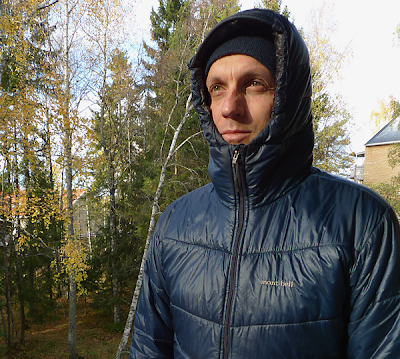
The Thermawrap Parka is basically a light, windproof and water resistant hooded jacket with a layer of synthetic insulation. Montbell describes it as:
"simple, light weight, synthetic insulation that remains thermally efficient when wet. Whether it be a frigid mid-winter bike commute into the office or a harrowing belay high on the Compressor Route".
That the jacket still insulates when wet is of course a big plus compared to a down equivalent, like the Patagonia Down Sweater, which would collapse when water soaked through its shell. Still, wet insulation is something you want to avoid in any case, so I would recommend carrying a rain shell too if there is a chance of rainfall. Mine is a size large and weighs in at 13.4 oz (380 grams) on my scale. It's worth noting that these run small due to it being a japanese jacket. I normally wear a medium, so order a size larger than you normally wear.
The fabric used in the outer shell and lining is 15 denier Ballistic Airlight nylon with a DWR (Polkatex). Its very soft to the touch and does an outstanding job in blocking the wind - so much that I will be taking a long hard look at their windshirts when I wear out my Montane Litespeed. Montbell brags about the DWR treatment, claiming it can resist 100 wash cycles. This has not been my experience. I don't think its either more durable nor more effective than that on other garments I've tried
The insulation is 80gr/m2 Exceloft which I've found is very effective even though the layer is pretty thin. I think the jacket feels so warm because of a combination of the insulation, the ability to block wind and the very nice hood. Talking about the hood, lets move on to features.
The cuffs have what Montbell describes as "wedge shaped stretch panels". I like these for two reasons: comfortable fit + sealing to avoid drafts and snow.
The hood is adjustable and has a nice, snug fit. My only gripe with it is the adjusters that are close to the face and can be irritating at times when they stick out.
You also get two zippered pockets, dual hem adjusters and a micro fleece beard guard. Montbell also includes a stuff sack.
Long term use
I've been using the jacket a lot since I bought it, both when out hiking and in daily life. When hiking I've mostly used it in camp and at rest stops as insulation and it's done a great job. In daily life it is my goto jacket for most of the year and it's always kept me warm with a base layer beneath it. We've been having some really cold weather here lately with temperatures plummeting to -15C and that's more than it can handle, so I'm using a MH Monkey Man fleece as midlayer to boost warmth. This is a very warm combo though so its not something to use while on the move.
The DWR wore away like all of them do eventually, so I had to use some Nikwax spray to reapply it. Tiny holes have appeared on the back due to abrasion, leading to small dots of insulation leaking out. Nothing to bad, but I would've expected it to take more abuse. I've also been having problems with the zipper splitting - I guess this is normal zipper wear, but I have seldom encountered it in other jackets. In my opinion they should've used a stronger and more durable zipper.
Sizing and availability
Montbell products are not available in Norway so I had to get the Parka from the states. They offer a wide range of sizes and both a mens and womens version. Note that the parka is part of a series of synthetic insulation products - they also have a jacket, pant and vest.
Conclusion
So, is this something I would recommend getting? Yes, I think so, but maybe not for longer trips like thru-hikes because of the relatively weak zipper. Overall I think it is a great insulation piece which is really versatile, and quite affordable too.







